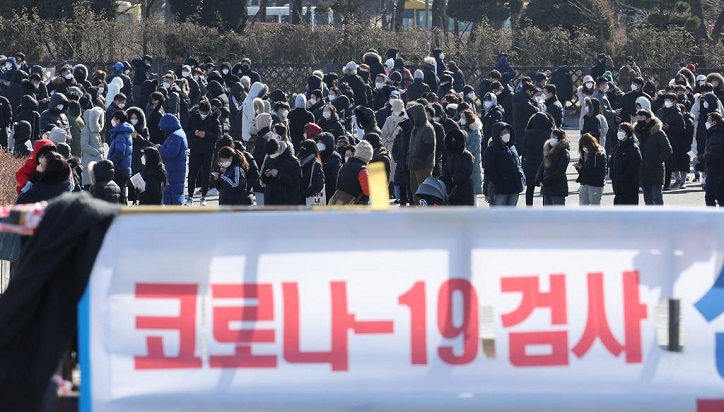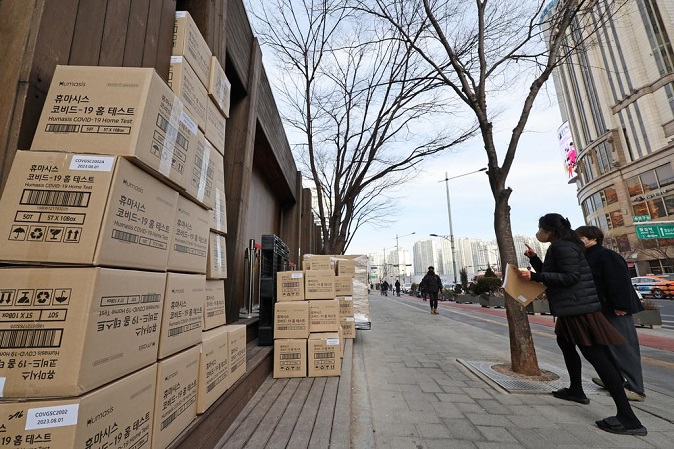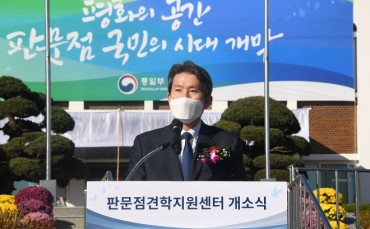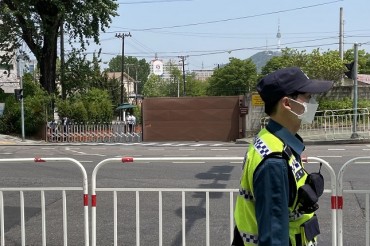
People wait in line to get tested for the coronavirus in Songpa, eastern Seoul, on Feb. 6, 2022. (Yonhap)
SEOUL, Feb. 7 (Korea Bizwire) — South Korea’s daily coronavirus cases are likely to hit a record high amid the fast spread of the highly transmissible omicron variant, health officials said Monday.
As of 9 p.m., the country had reported 31,777 new COVID-19 cases, up 4,067 from the same time the previous day, according to health authorities and city governments.
It marked the first time that daily virus cases as of 9 p.m. had exceeded the 30,000 threshold. Daily cases are counted until midnight and announced the following morning.
The previous daily record high was 38,691 on Sunday.
South Korea reported 35,286 new COVID-19 infections Monday, raising the total to 1,044,963, according to the Korea Disease Control and Prevention Agency (KDCA).
The number of daily COVID-19 cases stayed above 35,000 for the third straight day Monday despite fewer tests over the weekend.
Daily infection tallies tend to slow on Mondays due to less testing on the weekend, but the fast spread of omicron appears to have broken the trend.
The KDCA said the country will ease some monitoring and quarantine measures for low-risk COVID-19 patients as the omicron variant continues to strain medical workers.
Health authorities said the number of new COVID-19 patients could possibly reach between 130,000 and 170,000 by the end of this month as omicron has become the country’s dominant strain.
The daily tally surged to over 30,000 for the first time on Saturday, just three days after breaking the 20,000 mark. The figure topped the 10,000 level for the first time on Jan. 26.
The accumulated virus caseload surpassed a grim milestone of 1 million the previous day, two years after South Korea reported its first COVID-19 case.
The death toll from COVID-19 came to 6,886, up 13 from Sunday. The fatality rate was 0.66 percent.
The number of critically ill COVID-19 patients was 270, down two from a day earlier, the KDCA said. The number has stayed in the 200s range for 10 days in a row.

This photo, taken Feb. 7, 2022, shows piles of boxes containing rapid COVID-19 antigen test kits, which were delivered to a state medical center in eastern Seoul. (Yonhap)
The authorities said the omicron variant is twice more transmissible than the previous delta variant, but it has up to about one-third chance of developing into severe cases.
The KDCA said intensive care unit beds for critically ill COVID-19 patients were 18.2 percent full nationwide, staying at a stable level.
At-home care patients rose 17,729 from the previous day to a total of 146,445 due to the fast spread of mild COVID-19 patients or those without symptoms, the KDCA said.
KDCA Commissioner Jeong Eun-kyeong even forecast at-home care patients may reach around 1 million by early March.
“The number of new patients has doubled for three weeks in a row,” Jeong said during a meeting at the National Assembly, adding that treatment should be more focused on patients aged 60 or older from now on.
The authorities said at-home care treatment will now be more focused on patients aged 60 or older, with up to 650 institutions across the country that could monitor up to 210,000 people.
The KDCA said the fast spread of the omicron variant has overwhelmed health workers and government officials, leading the authorities to end their daily checkup calls of low-risk COVID-19 patients treated at home.
The authorities said health officials will now make daily checkup calls to only high-risk COVID-19 patients in their 60s or older or those with preexisting medical conditions.
Low-risk patients, aged in their 50s or younger, will now be left to monitor their conditions by themselves and contact local hospitals if their symptoms deteriorate.
Also, COVID-19 patients will no longer be required to report to local health officials when they leave home to visit doctors, the KDCA said.
The authorities said family members of COVID-19 patients can now freely go out to buy food, medicine or other necessities despite being in the at-home care period.
Of the locally transmitted cases, Gyeonggi Province that surrounds Seoul reported 9,780, followed by Seoul with 6,873 and the western port city of Incheon with 2,366, the KDCA said. Daily new cases from overseas went down 34 from a day earlier.
(Yonhap)






